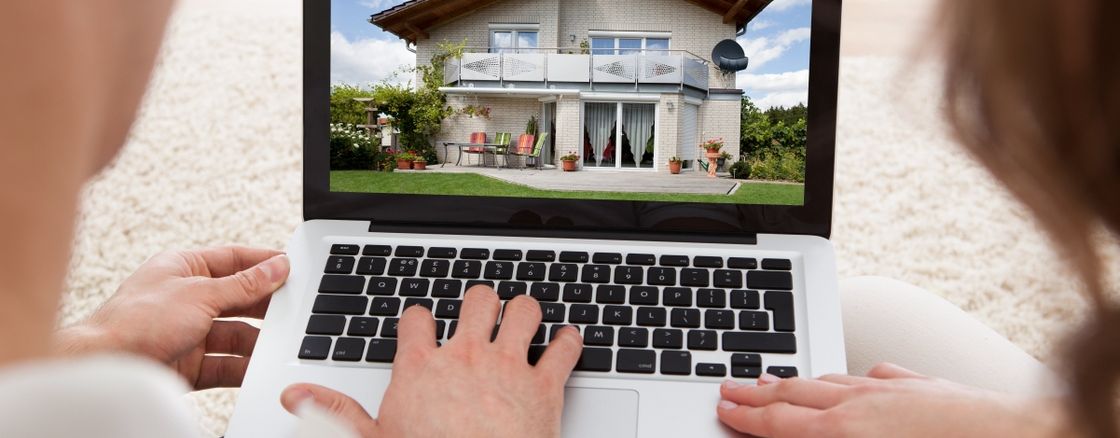How to Buy a House from Out of State
Written by:
Andrew Tavin
Andrew Tavin
Personal Finance Writer
Andrew Tavin a contributing writer for Own Up.
See full bio
Fact Checked by:
Dan Silva
Dan is the Vice President of Marketplace Lending at Own Up. Throughout his career, he has held executive leadership positions in the mortgage and banking industry.
See full bio

Congratulations! You just landed your dream job. There's only one problem: it's in a completely different state.
Finding a new home is difficult enough when you're searching down the street. It's even harder when you have to choose between virtual tours or flying out for your search. Thankfully the internet has made it easier than ever to research an area, learn about different properties, and work with agents and lawyers at a distance to close on a property.
Step 1: Assess Your Resources
There are many reasons why people choose to move, whether it's to be closer to family or to upgrade to a bigger place. Historically one of those reasons has been job relocation.
However, moving due to job relocation has become far less common, even in 2023. High mortgage rates and the continued availability of remote or hybrid work continue to cause muted demand for work-related relocation, even after the pandemic.
You can use this fact to your advantage when negotiating for leniency on the timing of the move, especially since some employers historically offered only a month or less. If this describes your situation, and you are unable to get an extension, consider temporary housing like a short-term rental or sublet. For those loyal to a hotel brand, this could be a great way to get those reward points for future travel. Overall, the goal is to start your search on the ground rather than rushing into a real estate transaction sight unseen.
Additionally, many employers offer some type of assistance with relocation costs: be sure to request this! Relocation packages can include assistance with moving expenses, including the cost of temporary housing.
Even if you're moving for a different reason or do not otherwise have access to relocation assistance, you should still consider all resources at your disposal.
For example, if you have friends or family already living in the new location, they may have a lead on a sublet or allow you to save money by staying with them temporarily.
Step 2: Research the Area
Let’s face it: moving to a new area is overwhelming. You probably have questions about the real estate market, property taxes, nearby activities, and the school system. It can be helpful to research this information using online resources like Facebook groups or subreddits. However, in this situation we strongly recommend hiring a real estate agent. Consider the real estate agent to be your expert on the local market. Hiring an agent is even more important if you have limited, if any, chances to check out the area before you move.
Need an agent? Try Homelight.com: this site asks questions and uses your answers to match you with the right agent. The free service gives you a short list of local agents aligned to your needs so you can interview a few and choose the one you'd like to work with. Regardless of how you find them, you want an agent who knows the local area and will send daily MLS listings and updates on price reductions for properties of interest. You also want to be sure they're willing to use Facetime or Skype to offer real-time virtual tours of properties from a distance.
If you are moving for a job, you can further narrow down your search location based on your future commute.
Step 3: Check the Listings
Once you've narrowed your focus area to part of a city or a few towns you can start looking at real estate listings.
Try searching online using sites like mls.com, Zillow, and realtor.com. As you find worthy houses in your price range you can take virtual tours, look at pictures, and check out Google Maps. Be sure to always check the accuracy of real estate sites.
Use the satellite function to get a street view of houses you are interested in. You want to get a sense of the neighborhood that may not be present in listing photos.
Step 4: Mortgage Pre-Approval
Before you're too far into your search, you should apply for a mortgage pre-approval letter. Pre-approval is kind of like a test run for actual mortgage approval.
Different lenders may have different requirements for pre-approval, but generally you'll submit proof of income and tax forms. The lender will issue you a pre-approval letter for a certain mortgage amount. While this isn't an actual approval, it will be helpful to show potential sellers that you're serious when making an offer.
If you already have an account with a national bank chain, you could ask them about their pre-approval requirements since they may have a presence in your future home as well.
Step 5: Purchasing Remotely
Thanks to modern technology, applying for a mortgage and purchasing a house can easily be done from another state as long as you're prepared.
In most states, shopping for a great mortgage rate can be done online regardless of your location. Be prepared with all the needed documentation to bring to your chosen mortgage lender or to send electronically.
The buyer's agent will facilitate most of the paperwork from your new city while you pack up and get ready to move. There are a number of items to tick off your list, many of which are done online or by phone.
You'll need a title company, insurance provider, home inspector, and appraiser. Odds are your agent or mortgage provider will have recommendations.
Step 6: Home Inspection
We get it: you’re in a rush to get a home. But never waive the right to a home inspection, as this will enable you to back out of the purchase if the property has problems that are not immediately apparent. Before the final papers are signed, you'll want to get a home inspector to walk through the property and sign-off that everything is safe and as advertised.
Buyers who have the ability to travel should consider attending the home inspection. If that's not possible, your real estate agent can attend on your behalf. Remember: having the professional inspection done will take the burden off of you to identify issues with the property.
If there are any issues that require fixing, you can negotiate the terms of the sale to address the repairs or lower the purchase price accordingly.
Step 7: Closing Time
The final step in the buying process is setting a closing date. Your lender will send you an itemized statement of closing costs, down payment, and any other charges. The closing itself takes an hour or so and generally involves signing a lot of paperwork.
Closing can be done remotely in most states, though it'll require notarized signatures on multiple documents. This requires visiting a local notary or using an online notary service.
If you have any questions, you can ask your agent or consult a real estate attorney.
You'll likely have to wire a significant amount of money, so be sure to double-check the wiring instructions and location.
Step 8: Move to a New State and a Great Home
Moving is a stressful event, and buying a second home thousands of miles away, possibly without seeing it in person beforehand, can be even more challenging. You should congratulate yourself on making such a big transition.
Keep in mind that you may need to donate or discard belongings that can’t travel with you: sometimes it is more cost-effective to buy new furniture at your destination after you’ve reassessed your budget. Try to set time to carefully pack the essentials so that it won’t be overly difficult or costly to make a long-distance move. You’ll need some extra packing boxes, bubble wrap, and safety for fragile items. For those really special and valuable items, we recommend bringing them with you to ensure their safety.
Finally, don’t forget to have your mail forwarded and your vehicle registered to your new address. Cancel or update any of those existing memberships that are tied to your old address.
Own Up has helped thousands of people become homeowners and worked with them throughout the homeownership journey. Whether you're looking for a place nearby or across the country, we're here for you. Soon enough, you’ll be enjoying your new home, wherever in the country you are!


